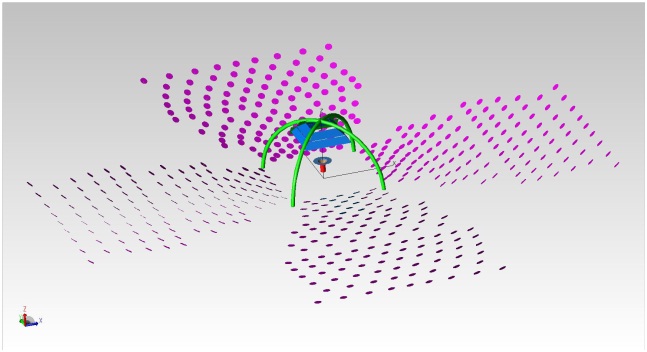
A non-standard configuration of a CSP system is that which uses one or more mirrors placed on a tower (in practice almost instead of the receiver in a standard CSP field) which have the task of returning the beam coming from the heliostats. This configuration is called "beam-down". Its great advantage is to be able to place the receiver low, almost at ground level, which is very useful in case the means of transferring the heat generated on the receiver is a fluid (or a fluid bed). However, the numerous disadvantages it entails must be considered: decrease in the amount of flux due to further reflection (about 10% loss in the best case), use of large deflection mirrors, unavailability of data on resistance and duration of mirrors subjected, in the external environment, to irradiation from 5 to 20 times greater than the standard solar irradiation (in fact an already concentrated beam arrives on the return mirrors). Figure 1 shows the diagram of a beam-down CSP field.

Another element that can be inserted in a CSP field is a particular secondary optic that allows to limit the size of the receiver, in order to reduce the losses due to radiation and convection: this optic is almost always represented by a CPC (Compound Parabolic Concentrator), whose shape corresponds to a surface obtained by rotating a parabola in space in a particular way. The CPC, which for solar applications is hollow inside, basically connects an entrance surface (the major "base") with an exit surface (its minor "base", which coincides with the receiver). Its shape allows each ray that enters through its major base (and which forms an angle with the axis of the CPC no greater than the acceptance angle of the latter) to exit the minor base after at most a reflection on the surface internal. The disadvantage is represented by the fact of having an extra reflection (with the exception of the rays that pass from one base to another of the CPC without being reflected on its walls) and by the constructive difficulties of the object, which can have a length of even some meter.
The personnel of the Solar Collectors Laboratory have the skills to design the entire optical part of a CSP system, with the exception of the heliostats handling system. It can also follow the construction phase by performing custom tests and measurements.
CNR-INO Istituto Nazionale di Ottica - Largo Fermi 6, 50125 Firenze - Tel. +39 05523081 - P.iva 02118311006 - Info: info@ino.cnr.it